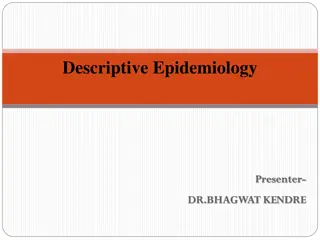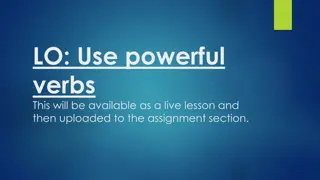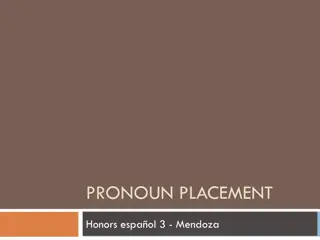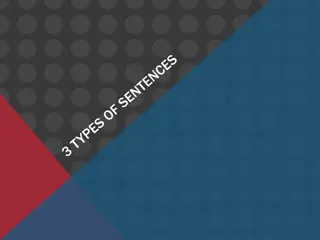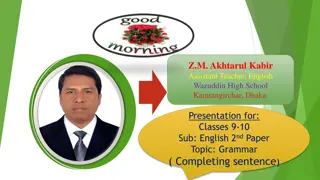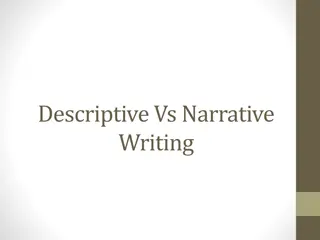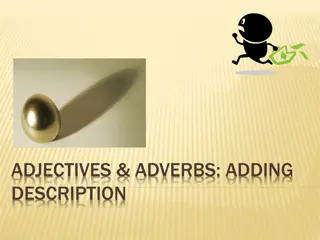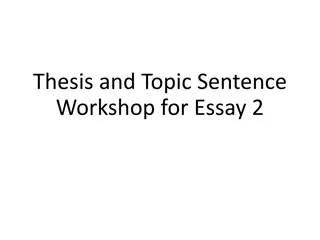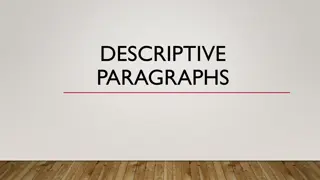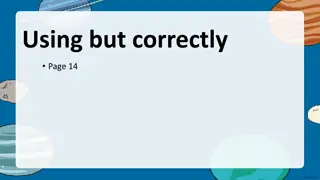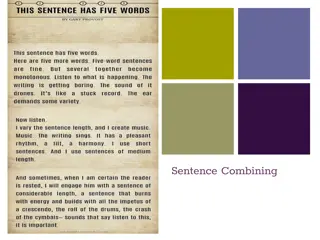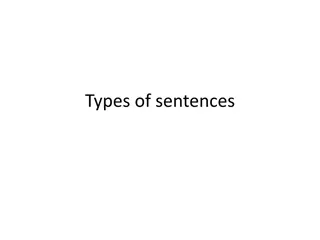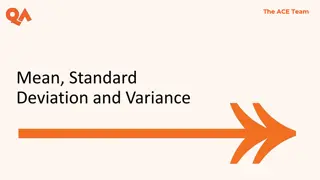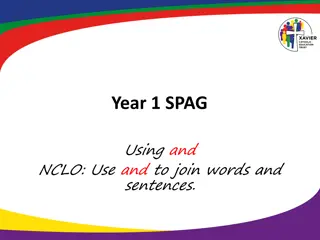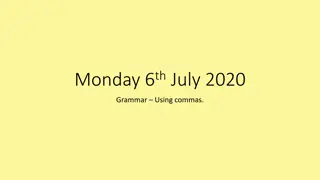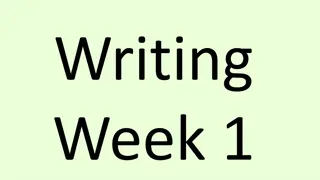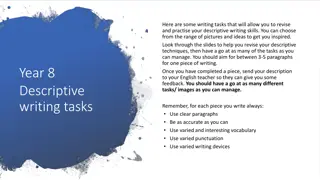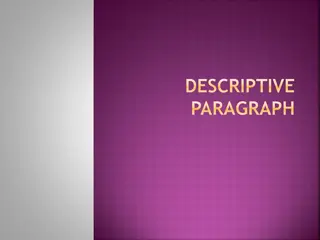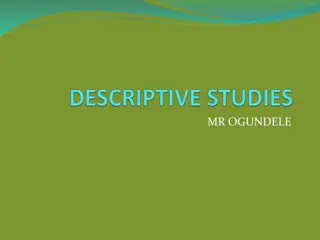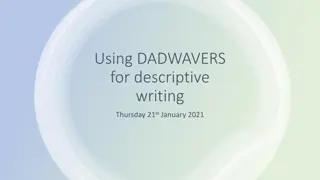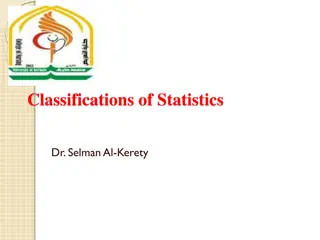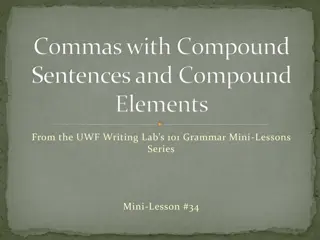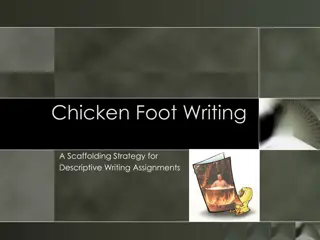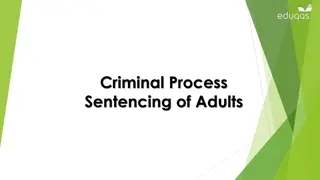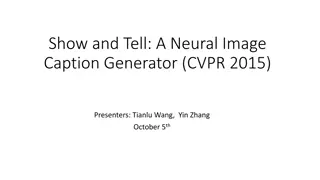Understanding Descriptive Epidemiology for Health Analysis
Descriptive Epidemiology, presented by Dr. Bhagwat Kendre, explores the distribution of diseases and related characteristics within populations. The study delves into factors like time, place, and person to identify patterns and formulate hypotheses about disease occurrence. Utilizing data from desc
3 views • 36 slides
Contrasting Concepts in Political Science: Normative vs Descriptive Approaches
Normative and descriptive concepts in Political Science explore contrasting viewpoints on how things should be versus how they actually are. While normative claims focus on value judgments, descriptive claims deal with facts. These concepts complement each other by providing both theoretical and pra
0 views • 10 slides
Understanding Predicators and Predicates in Sentence Semantics
Exploring the semantics of sentences, this content delves into the structure of declarative sentences in terms of predicators and arguments. It discusses various classes of items that can function as the predicator of a sentence, such as lexical verbs, the copulative verb "be" in equative sentences,
1 views • 39 slides
Understanding Loose, Periodic, and Balanced Sentences
Explore the definitions, rhetorical purposes, and examples of loose, periodic, and balanced sentences. Understand how these sentence structures impact readability and communication. Learn to differentiate between loose sentences with the main point at the beginning and periodic sentences with the ma
0 views • 18 slides
Mastering Powerful Verbs for Descriptive Writing
Learn how to enhance your writing by incorporating powerful verbs. Practice identifying verbs, adverbs, and nouns, and unleash your creativity by crafting sentences using dynamic action words. Explore the vivid descriptions of natural disasters like volcanic eruptions through engaging activities and
0 views • 7 slides
Pronoun Placement Rules in Spanish Sentences
Clear up confusion around the placement of reflexive, direct object, and indirect object pronouns in Spanish sentences and commands. Learn the placement rules for different types of pronouns in statements and commands, including examples for single-verb and two-verb sentences. Understand the order o
2 views • 10 slides
Understanding Subject-Verb Agreement in English Sentences
Subject-verb agreement is crucial in English grammar to ensure sentences are grammatically correct. The subject of a sentence must agree with the verb in terms of gender, number, person, and case. Incorrect use of verb can lead to ungrammatical sentences. Learn how the subject and verb should match
0 views • 28 slides
Understanding Types of Sentences in English Grammar
Simple, compound, and complex sentences are fundamental components of English grammar. Simple sentences express a single complete thought, compound sentences combine two independent clauses with a conjunction, and complex sentences consist of an independent clause and one or more dependent clauses.
2 views • 12 slides
Understanding Completing Sentences in English Grammar for Classes 9-10
Delve into the concept of completing sentences with Assistant Teacher Z.M. Akhtarul Kabir from Wazuddin High School. Learn the definition, rules, and examples of completing sentences with various tenses like present indefinite, past indefinite, and past perfect. Enhance your grammar skills and abili
0 views • 17 slides
English Class Column Matching Practice for Learning Complete Sentences
In this English class practice session, students will learn to match parts of sentences to create complete sentences. The practice involves columns A, B, and C with sentences focusing on education, wisdom, moon and sun relationships, and national flag symbolism. By the end of the lesson, students wi
0 views • 21 slides
Understanding Descriptive vs. Narrative Writing Styles
Delve into the nuances of descriptive and narrative writing, exploring the differences between these two styles. Learn how each style conveys information, from sensory details in descriptive writing to storytelling in narratives. Discover similarities between the two styles and how to structure essa
2 views • 9 slides
Understanding Adjectives and Adverbs for Descriptive Writing
Learn how adjectives and adverbs enhance writing by adding specific details about people, objects, and actions. Adjectives modify nouns to make sentences more descriptive, while adverbs provide additional information about verbs or adjectives. Discover the importance of using these descriptive words
0 views • 26 slides
Crafting Effective Topic Sentences for Academic Essays
Understanding the importance of topic sentences in academic writing is crucial for creating cohesive and well-structured essays. This workshop explores the role of topic sentences in connecting paragraphs to the thesis statement, providing examples and guidance on how to craft effective topic senten
0 views • 7 slides
Different Modes of Transport to School Vocabulary and Sentences
Explore various ways to travel to school with vocabulary words and sentences. From riding a horse to taking a bus or scooter, discover how students commute to school in different ways. Enhance your understanding of transportation methods through engaging visuals and descriptive sentences.
0 views • 29 slides
Mastering Descriptive Writing: Creating Vivid Images with Words
Utilizing descriptive paragraphs helps writers paint a vivid picture for readers by engaging all senses through specific language and adjectives. This guide explores the components of a descriptive paragraph, from the topic sentence to supporting details and a concluding statement. Learn how to use
0 views • 17 slides
Exploration of Various Poetry Forms: Descriptive, Narrative, Dramatic, and Metaphysical
Poetry is a diverse art form encompassing descriptive portrayal, storytelling narratives, engaging dialogues, and profound metaphysical insights. Descriptive poetry vividly captures objects and scenes like paintings, narrative poetry weaves interconnected stories, dramatic poetry involves dialogues,
0 views • 11 slides
Understanding Sentence Structure: Simple and Compound Sentences Explained
Learn about the characteristics of simple and compound sentences with examples. Understand how to use conjunctions like "and" and "but" to connect ideas in sentences. Practice creating sentences using these structures and improve your writing skills.
0 views • 12 slides
Understanding Sentence Structure: Phrases, Clauses, and Compound Sentences
Learn about phrases, clauses, simple sentences, conjunctions, and compound sentences in English grammar. Understand the differences between independent and dependent clauses, how to form compound sentences using conjunctions, and practice writing sentences about Justin Bieber. Explore the components
1 views • 21 slides
Understanding the Four Types of Sentences
Declarative, imperative, interrogative, and exclamatory sentences each serve a unique purpose in communication. Declarative sentences state facts, imperatives give commands, interrogatives ask questions, and exclamatory sentences express strong emotions. By recognizing the characteristics of each ty
0 views • 18 slides
Understanding Descriptive Statistics: Mean, Standard Deviation, and Variance
Explore the fundamentals of descriptive statistics focusing on mean, standard deviation, and variance. Dive into the importance of these measures in interpreting data patterns effectively, with practical examples like analyzing the average height of individuals and understanding central tendency met
1 views • 23 slides
Fun with Connecting Words: Using 'And' to Join Sentences
Explore the concept of using the word "and" to join words and sentences together. Practice joining phrases, sentences, and creating silly sentences. Engage in activities to understand sentence structure and enhance language skills.
0 views • 10 slides
Mastering Commas in Grammar: Activities and Practice
Embrace the art of using commas correctly by engaging in various activities and watching informative videos. From understanding the dangers of incorrect comma usage to practicing with quizzes and worksheets, this session focuses on honing your skills. Dive into the world of commas through engaging t
0 views • 31 slides
Fun with Writing: Simple Sentences and Wow Words Exploration
Explore the fundamentals of writing with simple sentences and enhancing vocabulary using wow words. Learn how to construct sentences, identify parts of speech, and make your writing more engaging through descriptive language. Practice by creating your own sentences and incorporating new vocabulary.
0 views • 12 slides
Enhancing Descriptive Writing Skills Through Engaging Tasks
Explore a variety of writing tasks designed to enhance descriptive writing skills, including using nouns, adjectives, verbs, and adverbs creatively. Learn about descriptive techniques such as metaphors, similes, and imagery to enrich your writing. Practice choosing precise vocabulary to create diffe
0 views • 8 slides
Exploring the Art of Descriptive Writing
Descriptive writing aims to immerse readers in a sensory experience by vividly portraying people, places, or things through carefully chosen details. Description paragraphs should focus on action over sensations, providing essential information in a clear, detailed, and chronological manner. The ele
0 views • 5 slides
Understanding Descriptive Epidemiology in Public Health
Descriptive epidemiology involves the study of disease occurrence and distribution in populations. It focuses on describing patterns of disease occurrence based on who gets sick, where rates are highest and lowest, and temporal patterns of disease. Descriptive studies are essential for public health
0 views • 18 slides
Statistical Analysis: Descriptive and Inferential Techniques Overview
Understanding statistical analysis involves both descriptive and inferential techniques. Descriptive statistics focus on summarizing data, including measures of central tendency and dispersion. In contrast, inferential statistics use sample data to make inferences about populations and test hypothes
0 views • 19 slides
Engaging Descriptive Writing Techniques with DADWAVERS
Explore the creative world of descriptive writing through the innovative use of DADWAVERS technique. Dive into a scene depicted in the image and craft your unique description using vivid vocabulary and engaging sentences. Unleash your imagination and bring the setting to life with your words in this
0 views • 6 slides
Evolution of Linguistics: From Philosophy to Descriptive Study
Linguistics has evolved significantly from being a branch of philosophy to a distinct field called Descriptive Linguistics. It now focuses on studying language in itself rather than in relation to other disciplines, aiming to describe and analyze the structure and operation of languages at different
0 views • 20 slides
Different Classifications and Guidelines for Descriptive Statistics
This content discusses the two broad classifications of statistics - descriptive and inferential. It delves into descriptive statistics, which help organize and summarize numerical data, and explores various ways to categorize them. It covers measures to condense data, central tendency, variability,
0 views • 26 slides
Understanding Structurally Sentences: Simple, Compound, and Complex
Learn about structurally sentences - simple, compound, and complex. Understand the different sentence types, learn to make sentences using these structures, and explore the use of coordinating and subordinating conjunctions. Enhance your skills in changing sentence structures and grasp the essence o
0 views • 19 slides
Understanding Sentence Structure: Simple, Compound, and Complex Sentences
Explore the basics of sentence structure through simple sentences with one independent clause, compound sentences containing multiple independent clauses, sentence fragments, and complex sentences combining an independent clause with a dependent clause. Examples and guided practice included.
0 views • 22 slides
Mastering Commas in Compound Sentences
Learn how to effectively use commas in compound sentences and compound elements. Discover when to include commas before coordinating conjunctions that separate complete sentences and when it's appropriate to leave them out for short sentences. Understand when not to use commas when coordinating conj
0 views • 4 slides
Chicken Foot Writing: A Scaffolding Strategy for Descriptive Assignments
Chicken Foot Writing is a helpful tool for organizing and structuring descriptive writing tasks, guiding students through transforming rough notes into well-constructed paragraphs. This strategy, developed by Keith Brown, aids in independent thinking and efficient completion of literary assignments
0 views • 8 slides
Transforming Complex Sentences to Simple Sentences - Lesson Overview
In this lesson, students will learn how to transform complex sentences to simple sentences in English grammar. The lesson covers the structure of complex sentences using conjunctions like "Though" and "Although" and guides students on converting them into simple sentences with expressions like "In s
0 views • 12 slides
Understanding Types of Sentences in English Grammar
Types of sentences in English grammar include clauses - independent and dependent. Independent clauses stand alone, expressing complete thoughts, while dependent clauses rely on independent clauses. Different types of sentences include simple, compound, complex, and compound/complex sentences. Simpl
0 views • 41 slides
Elevate Your Writing: Enhance Your Sentences Creatively
Revamp your dull sentences by incorporating new words, adding descriptive details, and infusing creativity into your writing. Transform mundane phrases into engaging narratives that captivate your readers. Explore various techniques to elevate your writing and make your sentences come alive with viv
0 views • 7 slides
Overview of Adult Sentencing in Criminal Justice
Adult sentencing in criminal justice involves four main categories of sentences available to the court: custodial sentences, community sentences, fines, and discharges. Custodial sentences for adults can range from weekend prison to life imprisonment, with mandatory life sentences for certain seriou
0 views • 21 slides
Understanding Adult Sentencing and Custodial Sentences
Adult sentencing involves 4 main categories of sentences: Custodial sentences (including mandatory life sentences), Community sentences, Fines, and Discharges. Custodial sentences for adult offenders can vary in duration from weekend prison to whole life imprisonment, with some offenses mandating a
0 views • 24 slides
Neural Image Caption Generation: Show and Tell with NIC Model Architecture
This presentation delves into the intricacies of Neural Image Captioning, focusing on a model known as Neural Image Caption (NIC). The NIC's primary goal is to automatically generate descriptive English sentences for images. Leveraging the Encoder-Decoder structure, the NIC uses a deep CNN as the en
0 views • 13 slides
